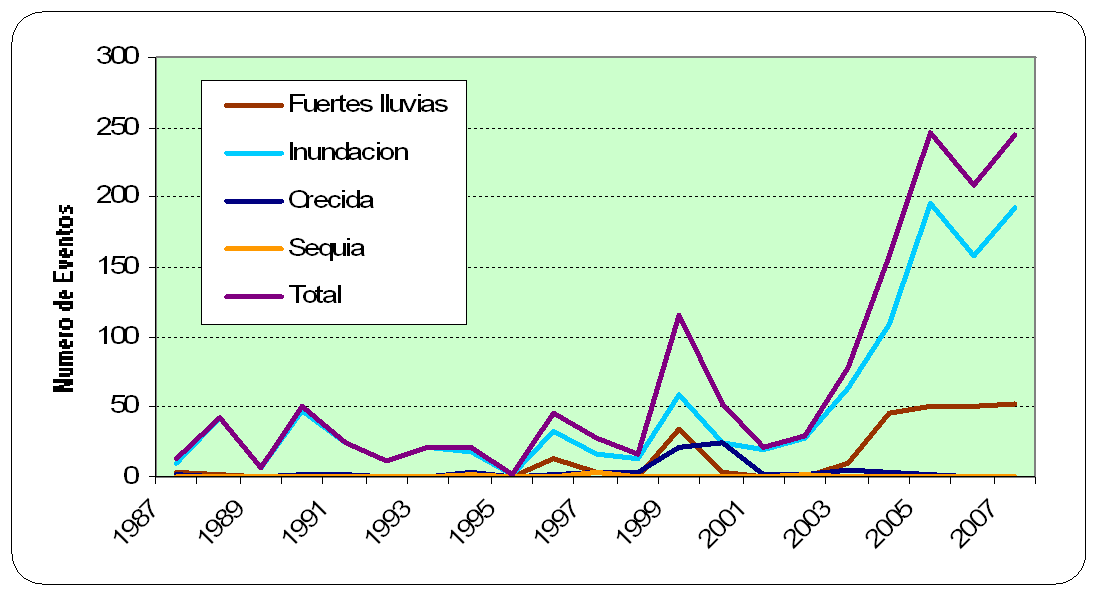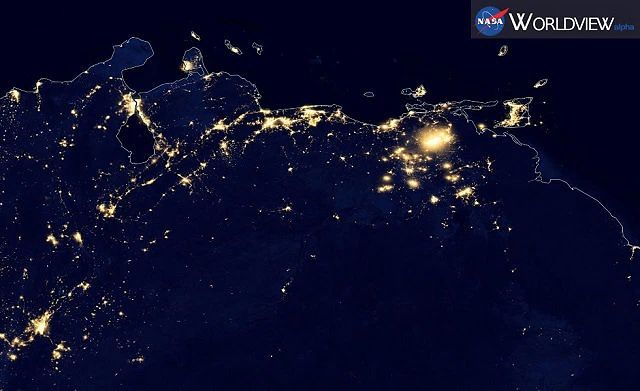The Venezuela Climate Change Will Leave Us
Venezuelans tend to think of Climate Change as a kind of “First World Problem.” But the country’s already suffering its effects, and coming decades promise much, much worse.


An astronomer from Mars would probably conclude the capital of Venezuela is Punta de Mata.
Punta de Where?! It’s a spot an hour’s drive west of Maturín, out in Monagas State — and as NASA images show, at night it’s much brighter than any other place in the country.
Far from a thriving metropolis, though, Punta de Mata is home to the world’s largest gas flare, that iconic, wild flame burning intensely atop a pipe commonly seen in oil fields.
Gas flaring is a practice so wasteful you’d think something like that can’t imaginably still be happening in 2017. It’s what you do to get rid of associated gas – that is, Natural Gas that also happens to come out in the process of extracting oil from a well – when you don’t have the infrastructure in place to harness this valuable energy source. It is, in other words, like burning off the $5 bills you get in the process of drilling for $100 bills because you don’t have a place to put them all.
Gas flaring also happens to be an important source of carbon dioxide emissions, a greenhouse gas. According to the World Bank, Venezuela was the tenth top gas flaring country in 2011.
It is now the fifth.
Human rights watchdog PROVEA, has pointed out that the environmental impact of this practice, widely used in Venezuela’s oil industry, has not been properly analyzed, adding that there are no plans to control emissions produced by mechurrios or to demand they comply with environmental norms and standards.
I was reminded of the megaflare in Punta de Mata as I read about Nicolás Maduro’s violent condemnation of the United States following Donald Trump’s decision to withdraw from the Paris Agreement. Flaring is just one example of Venezuela’s shockingly negligent attitude towards environmental problems of every sort.
As the world still recovers from the shock of seeing Donald Trump turn his back to the Paris Agreement, I couldn’t avoid thinking how much of Venezuela’s inaction in the field of climate change could just well be under the radar, and how much are we affected by it.
Reasons to act
Growing up in Caracas, I remember walking the streets of San Bernardino, a neighborhood sitting right at the foot of our beloved Cerro El Ávila, to go to school. As my sisters and I made our way uphill, the Avenida Vollmer used to be filled with a thin layer of fog in the cool, early morning hours. This is no longer the case. In fact, during the 20th Century the average temperature in Venezuela rose between 1 and 3°C.
Extreme climate events like torrential rains, massive flooding and mudslides, droughts and hurricanes… it has already started to displace people from their homes.
Professor Juan Carlos Sánchez explained to me that Venezuela is extremely vulnerable to climate change, mainly because of its population distribution along coastal lines and unstable terrains. Sánchez’s name always comes up when you talk to environmental activists about climate change: he’s a co-recipient of the 2007 Nobel Peace Prize for his work within the Intergovernmental Panel on Climate Change (IPCC) – that’s right, he’s Venezuela’s sole Nobel laureate. As Professor Sánchez stresses, 75% of all Venezuelans live in the 20% of the territory in states facing the country’s coast, primarily Zulia, Miranda, Carabobo and Aragua states.
He explained climate change is producing two kinds of effects: the visible, more immediate type, and then other effects that are slower and longer term. Among the first are extreme climate events like torrential rains, massive flooding and mudslides, droughts and hurricanes. He cites the increasing frequency of these events in recent years and the way it has already started to displace people from their homes.
The haunting images of loads of mud, trees and rocks rolling downhill sweeping along cars, houses and debris during the 1999 Vargas state flash floods have begun to fade from memory. Numbers are hard to pin down, but the human toll was staggering: perhaps 25,000 people died and 20,000 houses were destroyed. While no single extreme weather event can be directly attributed to climate change, what you can say for sure is that such events are becoming more frequent. Like the 2005 vaguada in Santa Cruz de Mora, in Mérida State, which came to be known as the Mocoties tragedy: it left dozens dead and hundreds of homes devastated. Compounding the vulnerability, more and more urban slums (barrios) such as Petare are built on unstable terrain that is prone to mudslides, and disaster preparedness lags.
According to Sanchez’ own estimates, events like these are becoming more frequent, as well as other rare events like semi-tornados recorded in places like Caracas, Barcelona, and Maracaibo.

Source: Juan Carlos Sanchez 2009. Estudio CAV Aseguremos Nuestro Clima
The second category of climate change consequences in the country has to do with medium to long term processes, including raising air temperatures which in turn impact the water cycle, hurting food production and potentially bringing a wave of “climate refugees” as people move out of no-longer inhabitable areas.
Big parts of already-dry Falcon, Sucre, Lara and Zulia states, including the north of the Guajira peninsula, can expect desertification: the permanent degradation of the land and its capacity to carry crops, as a result of insufficient water. The pabellón criollo and even the iconic arepa are at risk: land degradation and decreased rainfall could make it difficult to impossible to grow corn, black beans and plantains in much of the country.
In general, water will become scarce in the coming decades as it will rain less over the country – in some regions up to 25% less than what they see today. Match this with out-of-date water management infrastructure and the result will be less running water. So the stories you hear from friends and family in Caracas or Valencia getting piped water just once or twice a week could just be the new normal: the way things will stay indefinitely into the future.
Less rain also means less electricity. By mid-century, Sánchez says that climate models estimate an 18% decrease in rainfall in the Caroní River basin that leads to the Guri dam, which generates 75% of the electricity Venezuelans use. Last year we had a taste of what it would be like to have less water poured into the hydroelectric complex, when its level decreased to alarming 249 meters, 22 below its desired level, prompting severe cuts in energy consumption. It also made electricity minister, Luis Motta Dominguez, don all his scuba diving gear to jump into the dam’s waters in a little understood quest that ended (as expected) with the now worn-out claims of sabotage: the government spends more energy making up excuses for not being ready for El Niño than in getting ready for El Niño.
Rising air temperatures bring an array of different effects, including glacier melting, a process that in the Andes has been occurring at an increasing rate since the 1970s. This means that the beautifully crisp white snows covering the Pico Espejo station, Merida’s cable car final stop at 4,765 meters above sea level, may not stay snowy much longer. In 2008, a local environmental group called Tatuy estimated that, under current conditions, the glaciers of Mérida’s Sierra Nevada, part of the Andes range, had a life expectancy of 12-13 years. Later in 2013 another study blamed climate change for what it called the unprecedented retreat of Andean glaciers.
Raising air temperatures also means more vector borne diseases such as dengue, chikungunya, zika and malaria. As temperatures rise, the bugs carrying them are able to survive in places where they couldn’t thrive before. Such is the case of the highland malaria now hitting the western state of Trujillo due in part to changing climate.
Low lying areas like Higuerote, Rio Chico, Puerto La Cruz and Tucacas may – should I say will? – disappear under the water as the sea level rises, another long term effect Sanchez points out is expected to happen sometime in the second half of the 21st century. Chances are much of Porlamar, on Margarita Island, will no longer exist when my young kids reach middle age.
The Venezuela climate change will bequeath us is nothing like the one we know today. And while it gets some constituent lip service, Venezuela has made virtually no moves to meet its Paris commitments.
https://twitter.com/RedsocialSAIME/status/867450202529181696
Tweets are nice. They’re more convincing, of course, when accompanied with substantive action, and a lot less convincing when they come from a government still running the world’s biggest gas flare. That’s a light that shines much, much brighter than a tweet.
Caracas Chronicles is 100% reader-supported.
We’ve been able to hang on for 22 years in one of the craziest media landscapes in the world. We’ve seen different media outlets in Venezuela (and abroad) closing shop, something we’re looking to avoid at all costs. Your collaboration goes a long way in helping us weather the storm.
Donate





